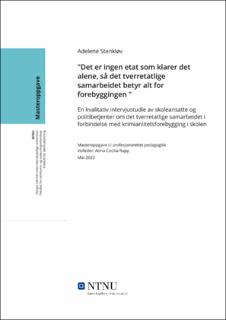| dc.description.abstract | Temaet for denne studien er kriminalitetsforebygging i skolen, i samarbeid med politiet.
Studien har som formål å gi innsikt i hvordan ansatte kan legge til rette for et godt tverretatlig samarbeid og belyse ulike faktorer som påvirker dette. I denne sammenhengen handler det om samarbeidet mellom skole og politi. Studien vil likevel kunne være relevant for andre gjennom at faktorene som belyses er gjeldende for andre typer samarbeid og institusjoner. Oppgaven ønsker også å gi innsikt til hvordan aktører kan forebygge kriminalitet i skolen, og hvordan samarbeidet mellom skolen og politiet åpner opp for ulike metoder og tiltak for denne type forebygging.
For å belyse dette temaet har denne studien som hovedformål å besvare følgende problemstilling: “Hvordan kan politi og skoleansatte samarbeide med å forebygge kriminalitet blant unge?”. Studien har en kvalitativ tilnærming med intervju som datainnsamlingsmetode. Gjennom intervju av 3 skoleansatte og 3 politibetjente får leseren innblikk i informantenes egne erfaring og opplevelser rundt det tverretatlige samarbeidet og hvilke refleksjoner de har rundt kriminalitetsforebygging. Informantenes refleksjoner kan gi innsikt i hvordan aktører kan utbedre og jobbe mer effektivt i et samarbeid, og hvordan jobbe kriminalitetsforebyggende i skolen. Disse refleksjonene bidrar til å bevisstgjøre hvilke faktorer som kan hemme og fremme et fruktbart tverretatlig samarbeid, også utenfor skole-politi samarbeidet.
For å gi et utvidet bakteppe rundt studiets sentrale funn inneholder det teoretiske rammeverket en introduksjon og redegjørelse for begrepene kriminalitetsforebygging og tverretatlig samarbeid, og hvordan skolen og politiet er forpliktet til dette gjennom eksempelvis opplæringsloven (1998) og politiloven (1995). Det teoretiske rammeverket presenterer også tidligere forsking på fremmende og hemmende faktorer i ulike tverretatlige samarbeid, og presentasjon av Scotts institusjonelle teori (1995). Teorien går ut på at institusjoner hviler på tre pilarer: regulativ, normativ og kulturell-kognitiv pilar. Den institusjonelle teorien brukes for å identifisere begrensninger og muligheter som oppstår i samarbeidet mellom politiet og skolen. Informantenes perspektiver og funn fra analysen blir drøftet i lys av det teoretiske rammeverket.
Gjennomgående i studien kommer det frem at informantene er fornøyde og positiv innstilt til et tverretatlig samarbeid, men at ulike faktorer er med på å påvirke kvaliteten og effektiviteten i samarbeidet. De sentrale faktorene som studien fremhever er organisering, relasjon og kunnskap. Faktorene er et tveegget sverd, gjennom at faktoren enten vil begrense eller styrke samarbeidet. Samtidig eksisterte det også institusjonelle hindringer for et optimalt samarbeid, som for eksempel begrensede ressurser og krav fra eksterne institusjoner. Innenfor forebyggingen viste det seg at politiet og skolene har ulik tilnærming til kriminalforebyggende arbeid i skolen. Et godt samarbeid vil kunne skape helhetlige tiltak for det beste for barnet. | |
| dc.description.abstract | The theme of this study is crime prevention in schools, in collaboration with the police.
The purpose of the study is to provide insight into how employees can facilitate good inter-agency collaboration and shed light on various factors that influence this. In this context, it is about the cooperation between school and police. The study may nevertheless be relevant to others through the fact that the factors that are highlighted are applicable to other types of collaboration and institutions. The thesis also wants to provide insight into how actors can prevent crime in schools, and how the cooperation between the school and the police opens for different methods and measures for this type of prevention.
To shed light on this topic, the main purpose of this study is to answer the following question: "How can the police and school staff work together to prevent crime among young people?". The study has a qualitative approach with interviews as a data collection method. Through interviews with 3 school employees and 3 police officers, the reader gets an insight into the informants' own experience and experiences around the inter-agency cooperation and what reflections they have about crime prevention. The informants' reflections can provide insight into how actors can improve and work more effectively in a collaboration, and how to work crime prevention in schools. These reflections help to raise awareness of the factors that can inhibit and promote fruitful inter-agency co-operation, also outside the school-police co-operation.
In order to provide an extended background around the study's central findings, the theoretical framework contains an introduction and account of the concepts of crime prevention and inter-agency cooperation, and how the school and the police are committed to this through, for example, the Education Act (1998) and the Police Act (1995). The theoretical framework also presents previous research on promoting and inhibiting factors in various interagency collaborations, and a presentation of Scott's institutional theory (1995). The theory is that institutions rest on three pillars: regulatory, normative and cultural-cognitive pillars. The institutional theory is used to identify limitations and opportunities that arise in the cooperation between the police and the school. The informants' perspectives and findings from the analysis are discussed in the light of the theoretical framework.
Throughout the study, it appears that the informants are satisfied and positive about an inter-agency collaboration, but that various factors contribute to influencing the quality and effectiveness in the partnership. The key factors that the study highlights are organization, relationship and knowledge. The factors are a double-edged sword, in that the factor will either limit or strengthen cooperation. At the same time, there were also institutional obstacles to optimal cooperation, such as limited resources and requirements from external institutions. Within prevention, it turned out that the police and schools have different approaches to crime prevention work in schools. A good collaboration will be able to create comprehensive measures for the best interests of the child. | |
